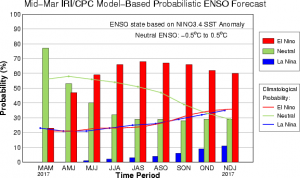Weather Trends Mt Everest
By Michael FaginEverest Basecamp, Mt. Everest Weather, Mt. Everest Weather Forecasting, Trekking EverestWeather Trends Mt. Everest. Spring 2017’s weather trends near Nepal – Mt. Everest. After a slightly wetter than average 2016 in Nepal, La Niña is subsiding and El Niño appears to be returning. On many occasions, this reappearance has proven troubling. The characteristic change in sea surface temperatures leads to a weakened monsoon and, most notably, crop irrigation deficits. The World Meteorological Organisation estimates that 90% of recorded El Niño years have led to below normal rainfall; and that 65% have led to droughts. While monsoons encouraged by La Niña are wonderful for farmers in India, the drier weather commonly experienced during El Niño years might be welcoming for those looking to climb the mountains of Nepal. What will be the Weather Trends Mt Everest? Read on.
El Nino
During El Niño, warm water leaves the western Pacific and shifts eastward toward the Americas. The bending of the jet stream in accordance with sea surface temperatures leads to trending dryness around the Indian subcontinent from late Spring through Summer. Due to air molecules bombarding and expanding in many directions, zones of lower atmospheric pressure are typical where the temperature is higher. Cooler air naturally drains into these spaces and so does any accompanying water vapor. The change brought by El Niño works to reduce chances of precipitation that otherwise may have fallen over the central Himalayas.
Sea Surface Temperature
Presently in the Bay of Bengal, the effects of the exiting La Niña are weak or already neutral. Surface temperatures are mostly below normal, with a minority of locations having risen slightly above normal. The Arabian sea to the west is almost wholly slightly above normal, which makes the effects on India and Nepal from the change in the Bay of Bengal somewhat dependent upon variations in wind direction.
Early indications point toward the formation of a weak El Niño which may stretch until at least the arrival of fall. The upcoming episode is not presently slated to become strong enough to make an historic impact on the region’s precipitation – a nearly typical Spring is expected. Spring 2017’s weather trends near Nepal – Mt. Everest – will depend on the averages established by local weather patterns.
Long-term El Niño Southern Oscillation (ENSO) predictions, however, are far from perfect and can change rapidly. For instance, the prediction of a solidifying El Niño for 2017 arose after models suddenly began to foretell the opposite of the conditions extrapolated in the couple months prior. Another known weakness in ENSO predictions is that most of the models tend to overestimate the warming experienced after La Nina events. The longevity and severity of the anticipated event will become much clearer this summer, when it’s presence, as presently foretold, will be most likely.

Current ENSO forecast
Weather Trends for Mt. Everest for 2017? This is always difficult to forecast in advance but certainly interesting to look at trends.
Article written Meteorologist Geoff Linslay
